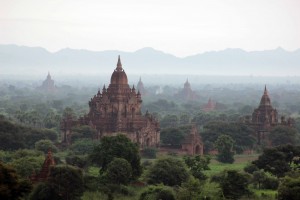VIETNAM, Cambodia and Myanmar are perfect examples of how travel can change the course of history. Thirty years ago, Vietnam was still recovering economically and psychologically from decades of war.
Twenty years ago, the horrors of the Khmer Rouge era were still fresh in Cambodia. Ten years ago, Myanmar (formerly Burma) was an international pariah, shunned because of its repressive military regime and the imprisonment of opposition leader Aung San Suu Kyi.
Tourism was limited to a few adventurous individuals or special interest groups. Now, they are firmly placed on the tourist map, all having experienced remarkable tourism growth. And given the attractions they offer, the friendliness of their people, and their brilliant cuisines, it makes perfect sense.
Of the three, Vietnam offers the widest range of experiences; from beach holidays right through to mountain trekking. It is also a land of contrasts, with Ho Chi Minh City, one of the most vibrant cities on earth, a stark contrast from the more sedate Hanoi with its leafy boulevards and serene lakes.
South of Ho Chi Minh City is the Mekong Delta, an endlessly fascinating region of floating markets, fish farms and non-stop waterborne commerce that features the lovely cities of Chau Doc and Can Tho. Central Vietnam’s Hoi An is a glorious spot,with a beautifully preserved historical centre and wonderful beaches. Just north is imperial Hue.
Halong Bay offers stunning scenery and the chance to travel through an ethereal landscape on a traditional junk boat, while west of Hanoi is hill country with Sapa at its core.
Tourism in Cambodia is understandably focused on the wonders of Siem Reap, headlined by the unparalleled Angkor Wat. But there are other reasons to visit Cambodia. Phnom Penh is a thriving city with a dark past, and as daunting as it may seem, visits to the S-21 prison and the Killing Fields are essential. Tonle Sap lake is a wonder to explore, and the south coast has some great little spots including Kampot and Kep-sur-mer.
Yangon, Myanmar’s capital, is slowly emerging from its torpor. Its main attraction is stunning Shwedagon Pagoda, but the city also rewards visitors with aimless walking along streets still lined with mouldering colonial buildings. Bagan is the chief destination with more than 1000 ancient pagodas and stupas spread over a broad plain, and further north are Mandalay, Sagaing, and Inle Lake. And through it all, the Ayeyawady River flows.
Myanmar’s tourism explosion has been extraordinary, with just over three million arrivals in 2014 compared with 791,000 four years earlier. Australians accounted for 29,000 of them. More than 321,000 Australians visited Vietnam last year out of a total of 7.84 million arrivals, while 134,000 visited Cambodia, which registered 4.5 million arrivals. Australian visitation increased modestly last year – by 0.5% for Vietnam, 1.6% for Cambodia and 2.6% for Myanmar, which saw an overall rise in tourism of more than 20% in 2014.
Myanmar’s tourism infrastructure has struggled to cope with the massive increase in visitation, a point stressed by Intrepid Travel managing director James Thornton. “In the earlier days there were difficulties with hotel bookings due to limited room capacity and high demand, combined with poor roads, and difficulties with food hygiene. However, we are seeing this gradually improve,” he says. “The current challenge is trying to set travellers’ expectations in a destination that is still developing in terms of tourism.”
Meanwhile, World Expeditions CEO Sue Badyari says Myanmar is slowly gaining ground on the ever popular destinations of Vietnam and Cambodia. “Although a comparatively newer entrant to the global stage, Myanmar is fast emerging as a sought after destination and our range of holidays there is growing in response,” she says. “Beautiful landscapes, rich history and culture, and amazing food make all three countries ideal destinations to explore.”
Insider Journeys managing director Paul Hole, who was a pioneer in the region back in the 90s, says South East Asia has come a long way in the past 30 years. And as the destinations continue to develop, he says new locations are opening up with easier access.
“A good example of this is the new highway to Sapa into the mountainous northern areas of Vietnam. Previously, the primary mode of transport had been limited to overnight train travel. The new highway, which links Hanoi and Lao Cai, now makes Sapa more accessible for our clients,” he says.
Certainly Vietnam, Cambodia and Myanmar will continue to evolve over the decades to come, but as the shackles on their past continue to loosen, the evolution is edging in the right direction.



